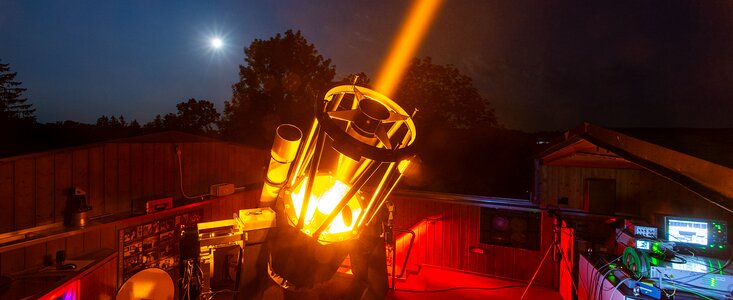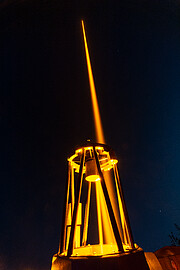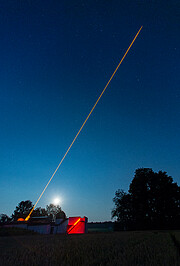Tiedote
ESO:n teknologiaan perustuva uusi tehokas laser on läpäissyt käytännön testin
31. elokuuta 2021
ESO:n teknologiaan perustuva kokeellinen tehokas laser selviytyi viime kuussa keskeisestä testistä, joka tehtiin Allgäuer Volkssternwarte Ottobeuren -observatoriossa Saksassa. Teollisuuden kanssa yhteistyössä kehitetyllä adaptiivisen optiikan laserilla on merkittäviä uusia ominaisuuksia nykyisiin järjestelmiin verrattuna. Se tulee olemaan osa CaNaPy Laser Guide Star Adaptive Optics -järjestelmää, joka asennetaan Euroopan avaruusjärjestön (ESA) optiselle maa-asemalle Teneriffalle Espanjaan osana ESO:n ja ESA:n tutkimus- ja kehitysyhteistyötä. Lähes kolme kertaa nykyisiä lasereita suurempi teho mahdollistaa myös laser-satelliittiviestinnän kehityksen sekä tuo merkittäviä parannuksia maanpäälisillä kaukoputkilla otettujen tähtitieteellisten kuvien tarkkuuteen.
Tähtitieteen adaptiivisella optiikalla tarkoitetaan maanpäälisissä teleskoopeissa olevia järjestelmiä, jotka korjaavat Maan ilmakehän turbulenssin aiheuttamia kuvavääristymiä. Turbulenssi aiheuttaa maan pinnalta nähtynä tähtien ”tuikkimisen”. Kuvavääristymien poistamiseksi nämä järjestelmät vaativat tutkimuskohteen lähellä olevan kirkkaan referenssitähden. Koska näitä tähtiä ei aina ole sopivasti kohteiden lähellä, tähtitieteilijät käyttävät lasereita, jotka virittävät 90 kilometrin korkeudessa maapallon ilmakehässä olevia natriumatomeja. Näin tutkimusalueen lähelle saadaan luotua keinotekoisia tähtiä, joiden avulla ilmakehän turbulenssia voidaan kartoittaa ja korjata.
Uusi kokeellinen laser perustuu samaan ESO:n teknologiaan, joka on käytössä 'Four Laser Guide Star Facility'-yksikössä. Se on tehokkaassa käytössä ESO:n Very Large Telescope eli VLT-kaukoputkessa Chilessä, sekä useissa suurissa tähtitieteen observatorioissa ympäri maailman. Näiden lasereiden teho on 22 wattia, mutta tämän uuden laserin teho on lähes kolminkertaistanut 63 wattiin, mikä on tähtitieteen lasertekniikassa valtava harppaus eteenpäin. Esimerkiksi tämä parantaa näkyvillä aallonpituuksilla adaptiivisten optiikan kuvien terävyyttä. ESO:n kanssa tehdyn yhteistyösopimuksen osana kanadalainen MPB Communications-yhtiö (yksi ESO:n alan kumppaneista) on pystynyt nostamaan infrapunalähteensä (Raman-kuituvahvistin, RFA) tehoa. Tämä on läpimurto, jonka avulla ESO CaNaPy laser pystyy saavuttamaan niin suuren tehon [1].
Tämän lisäksi saksalainen TOPTICA Photonics AG (myös ESO:n teollisuuskumppani) on kehittänyt ja toteuttanut uuden laserjärjestelmän CaNaPy-laserin taajuusmuutosjärjestelmän (frequency chirping system) osana ESO:n kanssa tehtävää tutkimus- ja kehitysyhteistyötä. Taajuudenmuutosjärjestelmässä (chirping) muutellaan nopeasti taajuutta, jolla laser on viritetty. Tämä lisää laserin virittämien natriumatomien määrää, mikä tekee keinotekoisesta tähdestä kirkkaamman ja parantaa siten turbulenssin aiheuttamien vääristymien korjausta. TOPTICA on asentanut taajuudenmuutosjärjestelmän prototyypin 63 watin laseriin. Se on ESO:n kanssa yhteistyössä rakentamassa havaintoja varten sekä laserin, että uuden taajuudenmuutosärjestelmän.
Tämä uusi kokeellinen CaNaPy-laser on esimerkki tähtitieteen teknologiasta, joka on kehitetty ESO:n ja teollisuuden kanssa yhteistyössä. Tällaista teknologia otetaan myös teollisuuden käyttöön uusilla aloilla, ja etsitään sovelluksia alkuperäisen käyttötarkoituksen lisäksi. Siten kehitystyö hyödyttää koko yhteiskuntaa. Kun CaNaPy-laitteisto on asennettu ESA:n Optical Ground Stationiin Teneriffalle (ESO:n [2] ja ESA:n yhteistyöhanke) se antaa molemmille organisaatioille mahdollisuuden edistää laser-aputähtien adaptiivisen optiikan teknologian käyttöä tähtitieteen lisäksi myös satelliittien optisessa viestinnässä. Optisen laserviestinnän avulla satelliitit voisivat lähettää ja vastaanottaa signaaleja Maassa molempiin suuntiin erittäin nopealla kaistanleveydellä. ESA tutkii parhaillaan tätä mahdollisuutta. Optinen lasersignaali voi siirtää paljon enemmän tietoa kuin radiosignaalit, mutta ilmakehän turbulenssi vaikuttaa niihin vastaavalla tavalla. Laser-aputähtien adaptiivisen optiikan teknologia voi siten parantaa huomattavasti satelliittien ja maa-asemien välisiä optisia yhteyksiä.
Lisähuomiot
[1] MPB Communications kasvatti 1178 nm:n infrapuna-alueella toimivan Raman-kuituvahvistimensa tehoa 36 watin tasosta, jota tavallisesti käytetään kaupallisissa natrium aputähti-lasereissa, ennennäkemättömälle 100 watin tasolle. Tämän ansiosta CaNaPy pystyy saavuttamaan 63 watin jatkuvan aaltotehon, kun se toimii 589 nm:n näkyvän allonpituuden alueella.
[2] Yhteistyössä on mukana useita ESO:n jäsenvaltioiden instituutteja: Istituto Nazionale di Astrofisica Italiassa, Durhamin yliopisto Yhdistyneessä kuningaskunnassa ja Instituto de Astrofísica de Canarias Espanjassa.
Linkit
- Messenger-artikkeli 'Laser Development for Sodium Laser Guide Stars at ESO'
- ESA Hydron-projekti
- Allgäuer VolksSternwarte Ottobeuren
- MPB Communications
- TOPTICA Photonics AG
Yhteystiedot
Domenico Bonaccini Calia
Physicist in the Laser and Photonics Group at ESO
Garching bei München, Saksa
S-posti: dbonacci@eso.org
Juan Carlos Muñoz Mateos
ESO Media Officer
Garching bei München, Saksa
S-posti: jmunoz@eso.org
Tiedotteesta
| Tunnistus: | ann21011 |
Our use of Cookies
We use cookies that are essential for accessing our websites and using our services. We also use cookies to analyse, measure and improve our websites’ performance, to enable content sharing via social media and to display media content hosted on third-party platforms.
ESO Cookies Policy
The European Organisation for Astronomical Research in the Southern Hemisphere (ESO) is the pre-eminent intergovernmental science and technology organisation in astronomy. It carries out an ambitious programme focused on the design, construction and operation of powerful ground-based observing facilities for astronomy.
This Cookies Policy is intended to provide clarity by outlining the cookies used on the ESO public websites, their functions, the options you have for controlling them, and the ways you can contact us for additional details.
What are cookies?
Cookies are small pieces of data stored on your device by websites you visit. They serve various purposes, such as remembering login credentials and preferences and enhance your browsing experience.
Categories of cookies we use
Essential cookies (always active): These cookies are strictly necessary for the proper functioning of our website. Without these cookies, the website cannot operate correctly, and certain services, such as logging in or accessing secure areas, may not be available; because they are essential for the website’s operation, they cannot be disabled.
Functional Cookies: These cookies enhance your browsing experience by enabling additional features and personalization, such as remembering your preferences and settings. While not strictly necessary for the website to function, they improve usability and convenience; these cookies are only placed if you provide your consent.
Analytics cookies: These cookies collect information about how visitors interact with our website, such as which pages are visited most often and how users navigate the site. This data helps us improve website performance, optimize content, and enhance the user experience; these cookies are only placed if you provide your consent. We use the following analytics cookies.
Matomo Cookies:
This website uses Matomo (formerly Piwik), an open source software which enables the statistical analysis of website visits. Matomo uses cookies (text files) which are saved on your computer and which allow us to analyze how you use our website. The website user information generated by the cookies will only be saved on the servers of our IT Department. We use this information to analyze www.eso.org visits and to prepare reports on website activities. These data will not be disclosed to third parties.
On behalf of ESO, Matomo will use this information for the purpose of evaluating your use of the website, compiling reports on website activity and providing other services relating to website activity and internet usage.
Matomo cookies settings:
Additional Third-party cookies on ESO websites: some of our pages display content from external providers, e.g. YouTube.
Such third-party services are outside of ESO control and may, at any time, change their terms of service, use of cookies, etc.
YouTube: Some videos on the ESO website are embedded from ESO’s official YouTube channel. We have enabled YouTube’s privacy-enhanced mode, meaning that no cookies are set unless the user actively clicks on the video to play it. Additionally, in this mode, YouTube does not store any personally identifiable cookie data for embedded video playbacks. For more details, please refer to YouTube’s embedding videos information page.
Cookies can also be classified based on the following elements.
Regarding the domain, there are:
- First-party cookies, set by the website you are currently visiting. They are stored by the same domain that you are browsing and are used to enhance your experience on that site;
- Third-party cookies, set by a domain other than the one you are currently visiting.
As for their duration, cookies can be:
- Browser-session cookies, which are deleted when the user closes the browser;
- Stored cookies, which stay on the user's device for a predetermined period of time.
How to manage cookies
Cookie settings: You can modify your cookie choices for the ESO webpages at any time by clicking on the link Cookie settings at the bottom of any page.
In your browser: If you wish to delete cookies or instruct your browser to delete or block cookies by default, please visit the help pages of your browser:
Please be aware that if you delete or decline cookies, certain functionalities of our website may be not be available and your browsing experience may be affected.
You can set most browsers to prevent any cookies being placed on your device, but you may then have to manually adjust some preferences every time you visit a site/page. And some services and functionalities may not work properly at all (e.g. profile logging-in, shop check out).
Updates to the ESO Cookies Policy
The ESO Cookies Policy may be subject to future updates, which will be made available on this page.
Additional information
For any queries related to cookies, please contact: pdprATesoDOTorg.
As ESO public webpages are managed by our Department of Communication, your questions will be dealt with the support of the said Department.



